Our long time friends Ted and Joanne Koopmans invited us to come along and house-sit a house that a friend of theirs had made available for 4 weeks in February. The prospect (and reality) of -30 weather in Edmonton in February, was but one reason we accepted their invitation. We also hoped we would learn and perhaps contribute a bit to our NGO host.
Ted and Joanne were Mennonite Central Committee (MCC) volunteers in Indonesia in the late 1980’s and still maintained contacts with MCC. Our host, Mark Richard had lived for many years in Guatemala and had started a wheelchair factory in association with the Christian, US based NGO Hope Haven International who has distributed over 130,000 wheel chairs globally . (Check out their impressive Google Earth graphic). He was in the United States for a few weeks in February and invited Ted to house sit.
We arrived in Guatemala City and were met by the regional manager from MCC who drove us to an MCC guest house for the evening. The next morning we had a great visit with MCC staff member and a walk to the MCC offices. There we were introduced to the 15 or so projects they were involved with here and in El Salvadore. Each project was managed by a partner organization and was typically related to agricultural production, education, or handicraft coops. They also showed us slides of the challenges and opportunities in Guatemala which is plagued with near obscene levels of wealth disparity, very high unemployment, corruption and narco gangs . We learned that the biggest source of foreign income for the country was remittances from those who have been migrated to Canada or the US. These hard economic facts underscore the challenges of Trumps proposed immigration policies and the need to develop local economic opportunities.
We then were picked up by a young driver from Mark’s organization and headed to Xenacoj a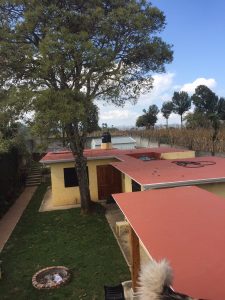 nd our home for the next 10 days. Mark lives alone but has a large house in a walled compound that also houses a guest house and dormitory for his many visitors. The house came with 3 large dogs (one tail in the picture at left!)
nd our home for the next 10 days. Mark lives alone but has a large house in a walled compound that also houses a guest house and dormitory for his many visitors. The house came with 3 large dogs (one tail in the picture at left!)
Later that afternoon we headed to the wheelchair factory. We were quite blown away by the scale of the factory- this was no mom and pop shop outfit. The factory manufactures two lines of wheel chairs – both designed to be fully adjustable so as to grow with the occupant and to be repaired with local materials. They also refurbish wheelchairs donated from North America.
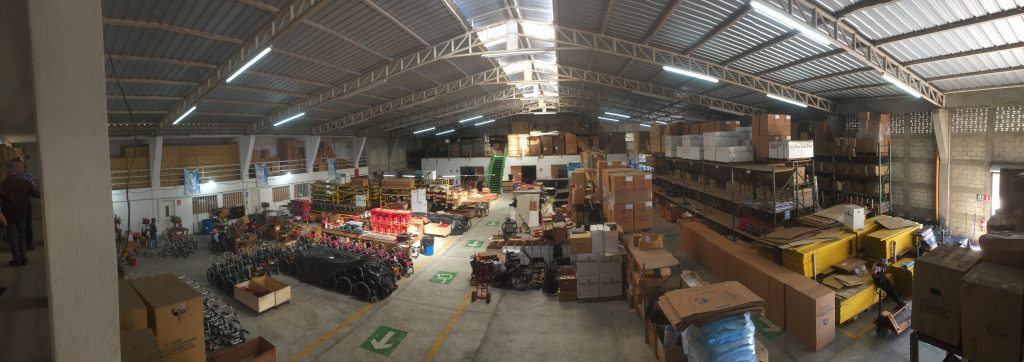
The Factory
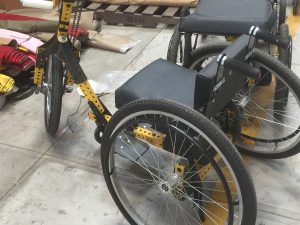
Hand Cranked Model

Standing Board
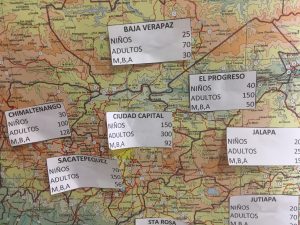
Current unmet need for wheelchairs
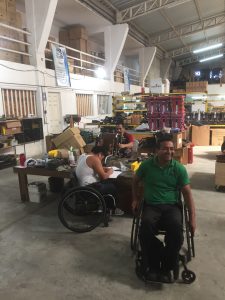
Workers at the Factory

Ted on a Bumblebee
The following day, we took it easy -enjoying the house. Ted, Susan and I went for a hike to the nearest town of Xenacoj. The town was only about 4 K away – but up and down the equivalent of a 23 story building (according to Google Health). I’ve come to appreciate the challenges of transportation in Guatemala as everywhere we have been thus far has been trough deeply cut ravines, up and down hills. There is lots of agriculture, most of which is one the sides of hills and sometimes gullies.
We enjoyed a pop overlooking the main square market and church and then bought some vegetables and chicken from women at the stalls dressed in bright traditional clothing. I bought an (expensive) bottle of wine to celebrate our arrival, but alas Susan slipped and fell on the way home and into a now wine-red ditch beside the road. Rather than attempt
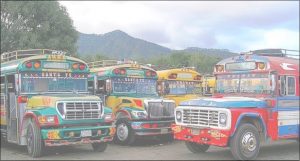
Chicken Buses
the ups and downs of the hike home we jumped on a ‘chicken bus’ and for some reason the drivers helper asked for .20 fare from all of the others in the crowded bus- but not from us. Likely the three who could most afford it rode for free! The chicken buses are used school buses imported from the US – some still bearing the name of the school division on the side. Soon after their arrival though most are re decorated with metres of chrome- running on all sides, as well as flashing lights and various insignia and religious statues – quote colorful, bu always crowded and zooming up and down the hills
We spend the evening watching the Olympics via CBC streaming video and Marks hi dev screen. We had assumed we’d be without such creature comforts, but we were able to cheer the Canadians on to a few medals.
The next day our young driver Josue, arrived early for an overnight trip north. We were
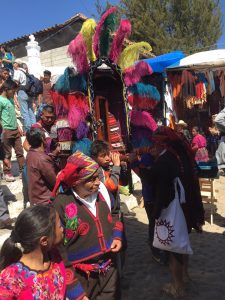
Religious Procession
heading for ChiChiCastenango, a town about 60 kms north. ChiChi holds one the largest markets in Central America. The streets in the centre of the town were closed and the locals set up temporary stalls. These sold everything from vegetables and treats, to shovels, pails and of course at least 20 varieties of corn which became tortillas- the staple food of Guatemala. It was also Sunday so we watched a couple of processions with relics and statues paraded around to the accompaniment of a drum, oboe like flute and fire crackers. We only bought a few things – but not for lack of invitations to purchase from the vendors.
At six o’clock the roads finally opened and we were able to get to our 2 star hotel. On a final walk around town, I found a smart phone on the street and with Josue’s help we were able to text the owners friends and 30 minutes later a very grateful owner appeared to reclaim the phone.
The next day we were up early to head to Lake Atitlan. one of the most picturesque and popular tourist sites in Guatemala. The road down to the coastal town of Panachel was unbelievably steep and twisty – we were very glad to not be driving. Heading for the lake front we took a wrong turn and ended up on a very narrow street with barely room for one vehicle and of course we met a car coming the opposite way- necessitating a nerve-racking reversal of 500 metres or so!
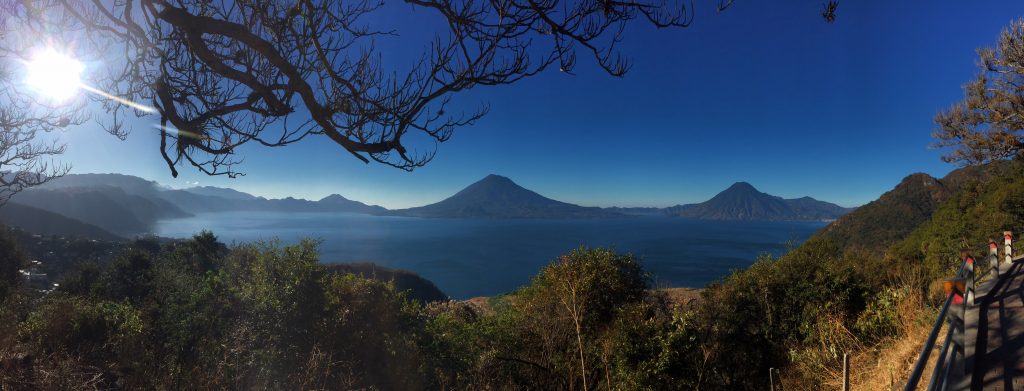
Lake Atitlan
The lake is surrounded by about 7 small villages- a few of which are only accessible by boat. With a fair bit of bargaining, we hired one of the 20 passenger, fibreglass water taxis and were soon heading across the lake to Santiago Atitlan. The wind had come up and the boat ride was a bit nerve racking as we rode up and over whitecaps and came crashing down on the far side. If we had of known that the return trip would be even rougher, we might have enjoyed the ride there a bit more. It is quite amazing that the fibreglass boats can stand the abuse.
Saiago, is a beautiful town on the lakeside with a host of tourist related craft booths lining the main street. The aggressive sales were a bit much. We stumbled upon a house
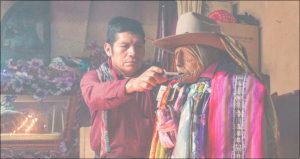
Maximon pauses for a smoke
with a preChristian cult (Maximon) in which a 400 year old (supposedly) idol could intercede with various gods for any request. Fortunately Maximon speaks EVERY language and for $4.00 allows his picture to be taken.
Next we hopped aboard a couple of Tuktuks (3 wheeled taxis) for a short trip to the Peace Park. This small park was a memorial to the 14 people killed when the Army open fire on a crowd of between over 1,000 civilians, who were protesting the Armies drunken abuse of San Diago citizens. This event was a turning point in both national and international resistance to the Army abuses of civilians during the guerilla wars. As results the Army is prohibited from entering the region, except to guard specific visiting public figures.
Next to the park we visited ANADESA the New Dawn Association of Santiago Atitlan. This
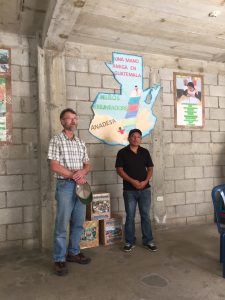
Ted Translating at ANADESA

Cool building at COOP
cooperative was formed after the MCC had been involved in relief work following a devastating mud slide that killed over 1,000 people following Hurricane Stan in 2005. MCC stayed on the support a Cooperative that focused on supporting women, providing education for children and youth and providing a centre for handicraft production. The members of the coop gave us an impromptu talk (with Ted translating). We bought a few handicrafts. It occurred to me that a visit from a volunteer artist type might be very useful in inspiring the manufacture of different handicrafts than those sold throughout the town.
We returned that night to our ‘home’ grateful to have seen a lot, survived the traffic. However, without Ted’s Spanish (acquired mostly through 4 years of study – much with Duolingo App on his iPad) this trip would have been MUCH more challenging. Maybe time for me to get a bit multi-lingual! We have a few more days here. Time to visit the museums in the capital and to put in a day or so of volunteer work at the wheelchair factory.